

Sowing the seeds of knowledge in
By Peri Kinder | peri.k@thecityjournals.com
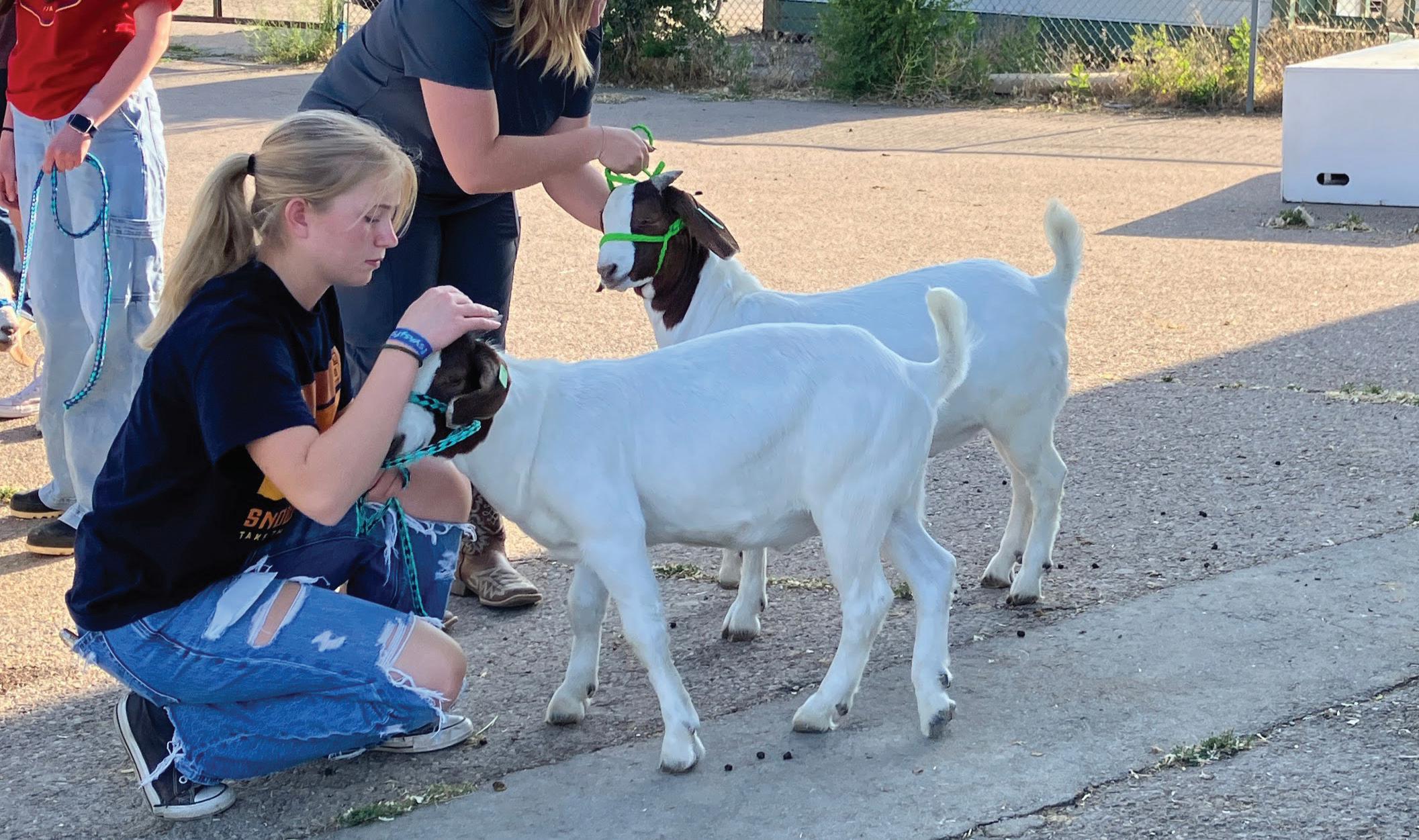
Editor’s note: In this special edition you’ll find articles related to all things food.
Farmers of America summer agriculture students not only understand where their food comes from, but they are actively involved in the process. Their summer has been spent growing their own food, raising livestock for auction, engaging with animals in the community and touring local agricultural sites.
“They choose their project and then we are just there to help them develop goals and help them improve through their project,”
Jordan Academy of Technology and Careers agriculture instructor Sydnee Roholt said.
One of the most popular summer programs is raising sheep, goats and pigs to show
only $20 or 3 for $50
American Heritage School 11100 S. Redwood Rd., S. Jordan Saturday, September 20 • 9am -2pm







and sell at the Salt Lake County Junior Livestock Show and auction taking place Aug. 6-9 at the Bastian Agricultural Center in South Jordan.
Miley Berg, a senior at Bingham High School, said the hands-on experience of caring for a lamb this summer has been good preparation for her future career as a veterinarian. She has learned what her lamb Eloise likes, where she prefers to be rubbed and how
page 4



Jordan School District students care for their animals, which are housed at the USU Bastian Agricultural Center. (Jet Burnham/City Journals)



Reclaiming Life: Innovative Approaches to Managing Chronic Pain
For many, chronic pain is a relentless companion, impacting every facet of daily life. But hope is on the horizon. Breakthroughs in pain management being used at CommonSpirit hospitals are offering new avenues for relief, moving beyond traditional methods to provide more targeted and effective solutions.
Chronic lower back pain is one of the most common challenges. One of the most promising advancements for managing chronic low back pain, particularly for individuals suffering from vertebrogenic pain, is radiofrequency ablation (sometimes referred to as Intracept). This minimally invasive treatment is designed to provide long-lasting relief and improve overall quality of life by addressing the source of the pain, rather than simply masking the symptoms. In this procedure, a small probe is inserted through a tiny incision and guided to the basivertebral nerve and then radiofrequency ablation is used to disrupt the nerve’s ability to transmit pain signals.
“Radiofrequency ablation represents a significant shift in how we approach chronic lower back pain,” explains Dr. Snigdha Ancha, a leading pain management specialist. “By directly targeting the nerve responsible for transmitting pain, we can provide lasting relief for patients who haven’t found success with other treatments.”
But what makes radiofrequency ablation
so effective? Traditional pain management often relies on medications, physical therapy, or injections, which can provide temporary relief but don’t always address the underlying cause. Intracept, on the other hand, offers a more permanent solution by disrupting the pain pathway. Studies have shown significant reductions in pain scores and improved function in patients who have undergone the procedure.
Beyond radiofrequency ablation, other innovative techniques are gaining traction. Neuromodulation therapies, such as spinal cord stimulation (SCS), are becoming increasingly sophisticated. These devices deliver mild electrical impulses to the spinal cord, interrupting pain signals before they reach the brain. Newer SCS systems are designed to be more comfortable and customizable, allowing for personalized pain relief.



“We’re seeing remarkable results with neuromodulation,” says Dr. Jeffrey Pence, a pioneer in pain management technology. “The ability to fine-tune the stimulation to match each patient’s unique pain pattern is a game-changer. It’s not just about reducing pain; it’s about restoring quality of life.”
In addition to these advanced procedures, a holistic approach to pain management is crucial. This includes:
• Physical Therapy: Strengthening muscles, improving flexibility, and restoring function
• Cognitive Behavioral Therapy (CBT): Helping patients manage pain through coping strategies and behavioral changes
• Mindfulness and Meditation: Reducing stress and improving pain tolerance
It’s important to remember that pain management is not a one-size-fits-all solution. The best approach is tailored to each individual’s specific needs and circumstances. A comprehensive evaluation by a qualified pain management specialist is essential to determine the most appropriate treatment plan.
If you’re living with chronic pain, don’t lose hope. The advancements in pain management are offering new possibilities for relief and a chance to reclaim your life. Talk to your doctor about the latest techniques and find a path that works for you.

Learn more about the services, care providers and missiondriven work of the Holy Cross hospitals and CommonSpirit Health at www.holycrossutah.org.

At CommonSpirit Health, we make the healing presence of God known in our world by improving the health of the people we serve, especially those who are vulnerable, while we advance social justice for all.
When minutes count, count on our emergency care. Get to know us before you need us.
When you need emergency care fast, the closest emergency room is a smart thing to know. You never know the level of care you’ll need when an emergency happens and choosing the right ER can make all the difference. And a hospital ER comes with the confidence of additional services right on-site.
Congratulations to CommonSpirit Holy Cross Hospital – Jordan Valley for receiving the Leapfrog Hospital Safety Grade-A Accreditation for the fourth consecutive time. Leapfrog Hospital Safety Grades are determined based on a rigorous assessment of various safety measures.
Find emergency care close to you at mountain.commonspirit.org
i số 1-303-673-8166 (TTY: 711).
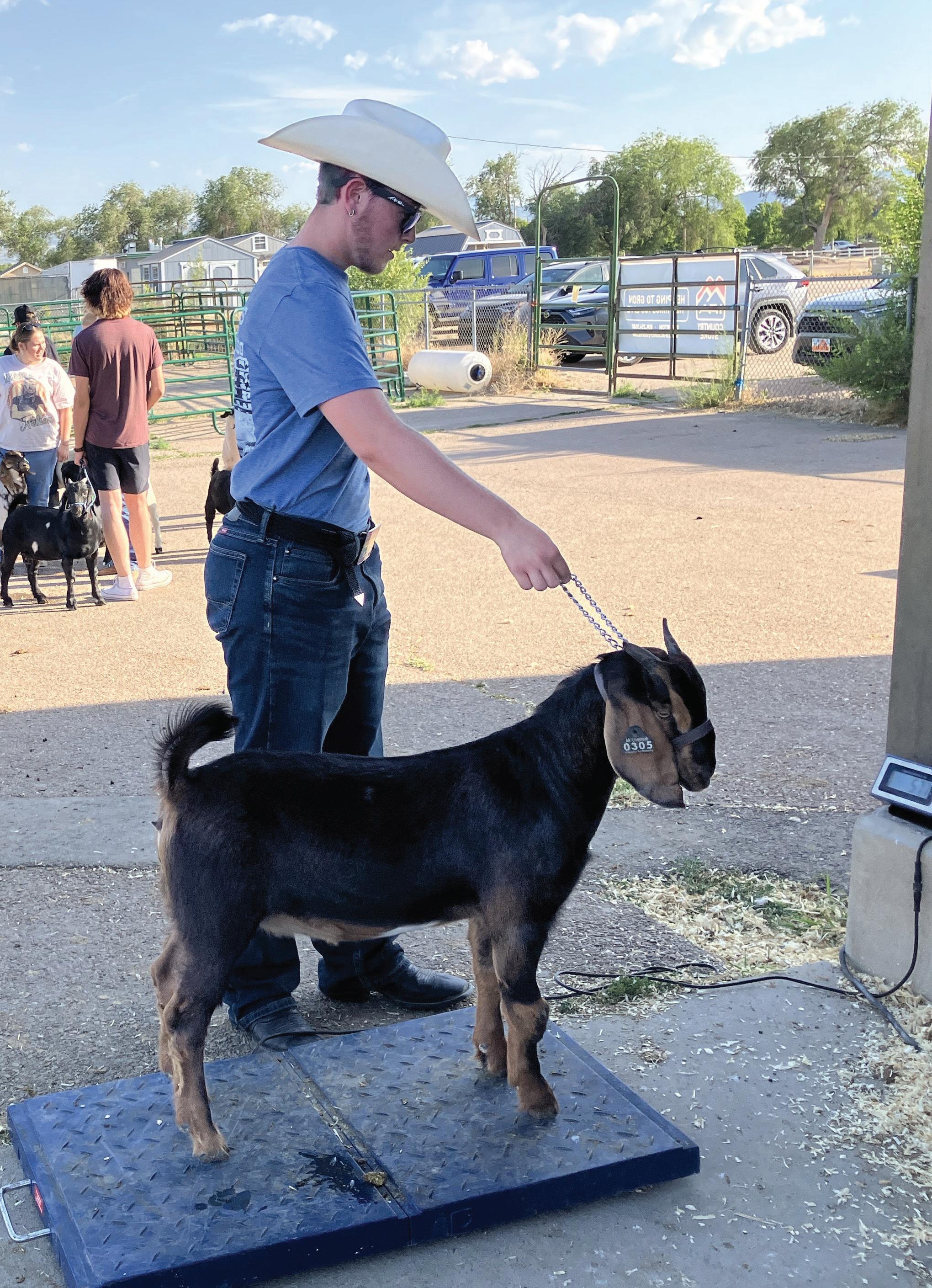
to calm her down.
Riverton High School junior Rachel Baggaley was excited for the chance to raise a lamb even though she knows it will be slaughtered for food.
“I eat meat and I understand and know where it comes from,” Baggaley said. “I know at least that she got someone that loved her, so I thought that it’d be better than her just not being cared about.”
Students become attached to their animals because they visit them every day all summer to feed, groom and train them. Jameson Evans became quite attached to his sickly goat last year as he nursed him back to health before he was donated to the food bank.
“I was happy that he was going to a family who needed him the most, and that’s what really gets me through this, that they’re going to the family that really needs the food,” he said.
Although Evans graduated from high school this year, he jumped at the chance to participate in the summer ag program one last time.
“I did it last year and it was super fun— it was the best summer of my life,” Evans said. “It brought me into an industry that I am passionate for, and I got another opportunity to do it even after I graduate so I was going to take the opportunity. It is honestly a life changing experience that I wouldn’t trade for the world.”
He plans to get an agricultural teaching degree and to someday breed livestock for 4H clubs to help kids learn about where their food comes from.
“Most kids are sitting in their basements playing Minecraft or Fortnite and they don’t really understand,” he said. “And so getting them out and about and learning about what it takes shows them there’s a lot more that goes into it than just going to the grocery store and picking it up.”
Some students earned their summer ag class credits for a variety of experiences at the
zoo, conservation gardens and tractor shows. Others counted the hours they worked at a doggy daycare or veterinary clinic. Many students’ projects centered on work they did at home, such as one student who raised mealworms to feed his family’s chickens.
“I have never seen a kid so proud of bugs,” Riverton High School agriculture teacher Kaylee Simpers said.
Sarah Atkinson, a senior at Riverton High School, helped grow more than 15 kinds of vegetables in her family’s quarter-acre garden and three kinds of fruit in their orchard. This fall, she will be canning the fruits of her labors.
“I’ve been gardening with my mom since before I could remember, and it’s been in my family for generations,” Atkinson said.
Her love of gardening led Atkinson to take science and agricultural science classes at school. She learned about threats to the environment and agriculture industry and has been inspired to find solutions. Her FFA Agriscience Fair project, a proposed solution for preserving soil for irrigated barrier crops, took first place at state and qualified for the national fair in Indianapolis this November.
Atkinson plans to make a difference in the agriculture industry by studying biological engineering in college, but she believes everyone should be educated about how the food they eat is produced so they can make more environmentally-sustainable and ethical decisions about what products they buy.
“Where you get your food from really does matter, and there are some places that you get your food from that are actually really horrible,” Atkinson said. “There are countless food items that you see every single day at your grocery store that use child labor, or slash and burn agriculture or horrible amounts of herbicides and pesticides with no regard for the environment. So just being more aware of what foods are good and what foods are bad for the environment could really help make a change.” l
The Riverton Journal is a monthly publication distributed directly to residents via the USPS as well as locations throughout Riverton.
For information about distribution please email hello@thecityjournals.com or call our offices. Rack locations are also available on our website.
The views and opinions expressed in display advertisements do not necessarily reflect or represent the views and opinions held by Loyal Perch Media or the City Journals. This publication may not be reproduced in whole or in part without the express written consent of the owner. © 2019 Loyal Perch Media, Inc.
PUBLISHER
Bryan Scott | bryan.s@thecityjournals.com
EDITOR
Travis Barton | travis.b@thecityjournals.com
ADVERTISING EXECUTIVES
Mieka Sawatzki | mieka.s@thecityjournals.com
Lindsay Andreasen | lindsay.a@thecityjournals.com
Jason Corbridge | jason.c@thecityjournals.com
Ryan Casper | ryan.c@thecityjournals.com
Marc Davis | marc.d@thecityjournals.com CIRCULATION
Rack
Lydia Rice | lydia.r@thecityjournals.com 385-557-1022
Anna Pro Ty Gorton
Stacey LaMont RIVERTON
9500 South 500 West, Suite 205 Sandy, UT 84070
PHONE: 801-254-5974
& Distributed by

RIVERTON TEAM
Jameson Evans weighs his goat to ensure she is on track to make the livestock show’s 50-pound minimum weight requirement. (Jet Burnham/City Journals)
North Italia serves up Italian cuisine with flair and fun
The modern Italian eatery brings handmade pasta and easy vibes to Riverton’s Mountain View Village.
By Peri Kinder peri.k@thecityjournals.com
With its rich Italian flavors and handcrafted cocktails, North Italia is shaking things up at Mountain View Village in Riverton. The upscale casual-dining restaurant opened in March and quickly gained traction as a place to find irresistible pasta, pizza and drinks.
General Manager Colin Corbello has been with the company for nearly 10 years, starting as a bartender and manager in Houston, Texas. When he got the opportunity to start the first North Italia in Utah, he jumped at the chance.
“North Italia is a modern Italian concept known for our scratch-made cuisine, handtossed pizzas and craft cocktails,” Corbello said. “As a newcomer joining Utah’s booming dining scene, the Riverton community has welcomed us with open arms. Everyone has made this opening such a smooth and exciting experience.”
In July, North Italia launched its Summer Sips event, mixing music and mixology with “The Greatest Sips” menu. The campaign features limited-edition drinks, created by bartenders across the country, inspired by iconic songs.
At North Italia’s Riverton restaurant, the zero-proof Everybody Talks combines watermelon, pineapple, lemon and soda for a light and summery taste that hits all the right notes. The citrus flavors keep the drink light and refreshing, and very sippable.
Christopher Reil manages the bar at the Riverton location and said the drink is elevated enough for adults to enjoy, but sweet and fun for kids, too.
“The non-alcoholic drink is inspired by the summer hit from Neon Trees, which graced our radios in 2011, and only guests in Riverton can experience this one,” Riel said. “The catchy and hook-driven chorus of ‘Everybody Talks’ imitates the seasonal vibe we are trying to create at North Italia Riverton, something that makes you want to get outside and enjoy quality time with friends and family. And what better way to do that than with delicious food and drinks?”
Other summer sips on the menu include Watermelon Sugar, inspired by the Harry Styles hit, combining Sugar House Vodka, watermelon, Aperol and fresh lemon. The Pink Pony Spritz is a bubbly, refreshing drink, incorporating Cinzano Bianco, Giffard Peche, Hendricks Grand Cabernet, Ramazzotti Rosato, prosecco and, of course, glitter.
The Summer Sips menu is available through Sept. 1. Along with the specialty drinks, North Italia offers a full-bodied wine
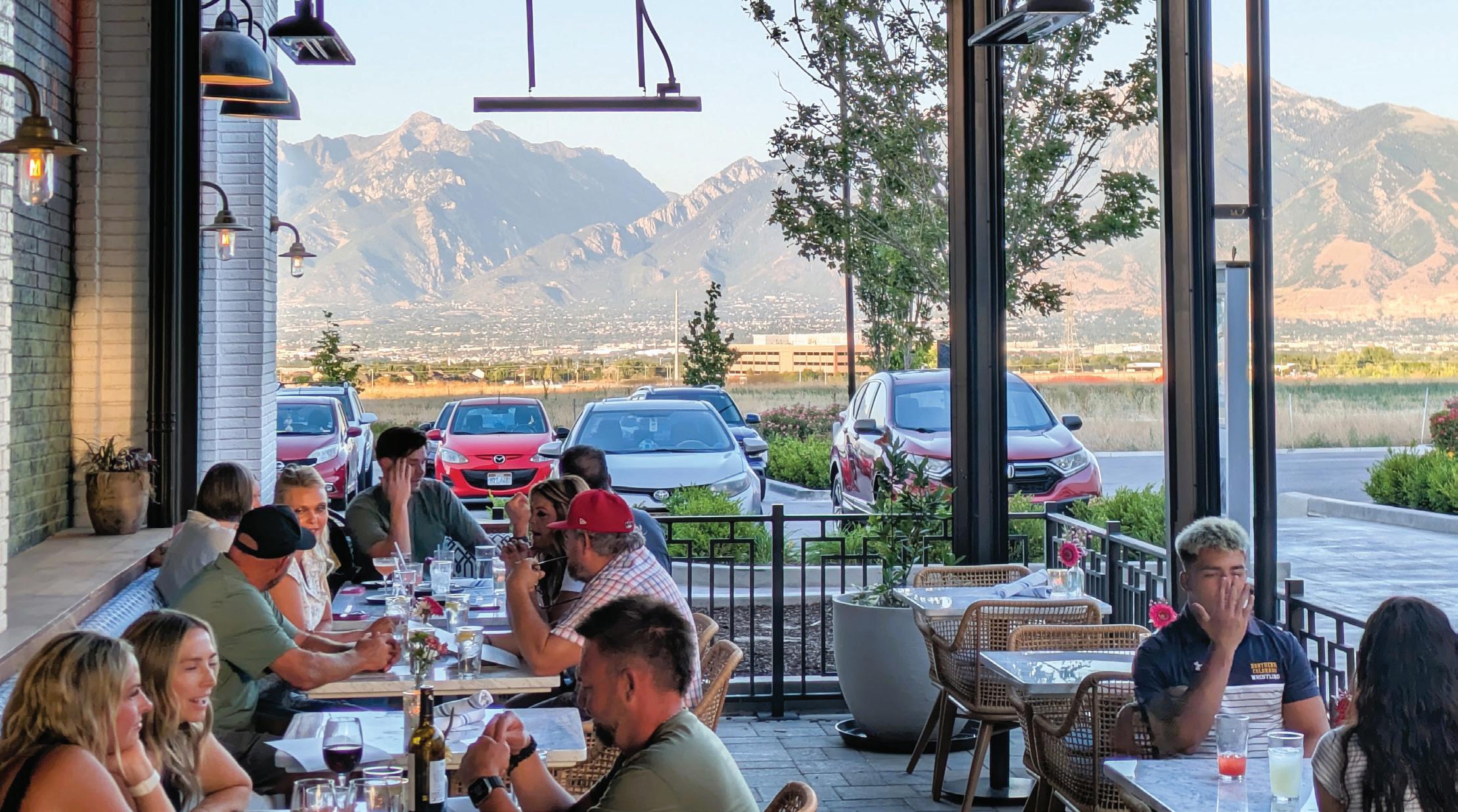


and beer list and an array of handcrafted cocktails to complement the mouthwatering food menu.
Come for the summer drinks, but stay for the Garlic Knot Sliders, available during happy hour and lunch. The sliders are a spin on a classic pizzeria offering, using housemade pizza dough to create slider buns. Patron favorites also include the seasonal heirloom tomato and burrata, followed by a hazelnut torta for dessert.
The spicy rigatoni vodka features Italian sausage with crunchy pancetta, and the chicken parmesan is a crispy cutlet smoth-
ered with tomato, provolone and mozzarella. Many menu items are also available gluten-free.
With its location in Mountain View Village, North Italia is the place to visit after a game at The Ballpark, shopping at nearby boutiques or a day out with the family. Corbello said the restaurant leans into the vibrant energy of the surrounding area that fosters a family-friendly atmosphere.
“We have a fully covered patio, making the restaurant a great place to enjoy the warm weather and mountain views. We’re also currently serving seasonal dishes using prime summer ingredients, such as roasted mush-
rooms, asparagus, cherry tomatoes, fava beans, sugar snap peas, blueberries and pistachios, so each dish is as fresh as possible.”
North Italia is located at 13303 S. Teal Ridge Way. It’s open seven days a week for lunch and dinner, with brunch served on Saturdays and Sundays. The restaurant features a Happy Hour on Monday through Friday from 3 to 6 p.m. For a complete menu or more information, visit NorthItalia.com.
“We invite you to stop by,” Corbello said. “Enjoy a dinner with friends and family or a weekend brunch to see what we are all about.”l
North Italia’s breezy patio features locally-inspired murals and grand views of the Wasatch Mountains. (Peri Kinder/City Journals)
North Italia General Manager Colin Corbello stands by a popular mural outside the restaurant at Mountain View Village in Riverton. (Peri Kinder/City Journals)
Bartender Dana Martin prepares handcrafted cocktails from the Summer Sips event, along with other drinks on the North Italia menu. (Peri Kinder/ City Journals)
Buddies, ribbons and joy: Unified Sports Day creates unforgettable memories
Nearly 1,000 Jordan School District elementary students with and without disabilities team up for a day of fostering friendships, building confidence and fun through inclusive sports.
By Julie Slama j.slama@mycityjournals.com
Heartland Elementary second-grader Charles Richardson beamed as he proudly showed his red ribbon.
“I got second place in running,” the 8-year-old said. “My favorite thing was running, throwing, jumping…I jumped all the way to the end and got a ribbon. I like achieving my goals. Zina helped me today.”
Zina, his peer buddy, was one of many student volunteers from elementary schools across the district who joined in the Unified Sports Day. The event brought together nearly 1,000 students from 15 schools in the Jordan School District to take part in activities such as the softball toss, 50-meter dash and long jump. Some even ventured into the longer “cross country” run.
The Unified Sports Day is held in partnership with Special Olympics Utah to encourage inclusion and teamwork between students with and without disabilities, said Courtnie Worthen, Special Olympics Utah’s Unified Champion Schools program manager.
“It brings an opportunity for students to compete and for students with and without disabilities to be excited about their friends’ accomplishments,” she said.
Jordan Secondary Teacher Specialist and Transition Specialist Ashley Calhoun chaired the Unified Sports Day committee. She coordinated the event alongside 45 volunteers, including Riverton High School student body officers and members of the Peer Leadership Team.
“We have students with like abilities compete against one another,” she said. “Prior to this, students are with their gen(eral) ed(ucation) peers for PE and the teacher modifies and adapts the activity to meet each kid’s needs. They practice these skills in PE and we score them so they can be matched to compete here.”
Jordan’s District Athletics and Activities Director Bryan Veazie said a major goal is to foster student leadership and create inclusive school cultures.
“We want all of our schools to become unified champion schools through the Special Olympics of Utah,” he said.
Historically, the event focused on giving students with different abilities a chance to compete in four sports. But last year, peer student leaders were invited to


participate alongside them. That pilot program grew and now all 15 schools have established leadership programs mirroring those at the middle and high school level, resulting in close to 1,000 elementary students participating.
To accommodate the increased participation, the event was split across two days and held at Riverton High School’s track and field. This helped keep the event manageable and enjoyable for all students.
“Another thing we decided to do is to make sure each school had T-shirts as before, some did and some didn’t,” Veazie said. “It has helped improve the organization of the event, helped teachers keep better track of their students and it helps create support for unified programs in the elementary schools.”
To provide the T-shirts, the committee partnered with the Jordan Education Foundation, which secured the donation from Destinations Travel’s Kip Lambert.
Shirts were coordinated to match each school’s colors, and students were allowed to keep them as mementos of the day, said JEF Executive Director Mike Haynes.
“It's been fun to see unified partners out running with buddies, doing all the events together,” he said. “It’s a big culminating event with a lot of excitement, and it engages the community to provide students’ success, engagement and inclusion. It’s one of the coolest things we do.”
At Monte Vista Elementary, sixth-grader Brianna Griffiths serves as a school ambassador and was paired with a buddy for the event.
“I look forward to seeing my buddy every day and working with them; every Friday, we play together in the gym, if it’s human hungry hippo, ping pong or hav-

ing a waffle party; it’s always lots of fun,” she said. “We’ve been looking forward to sports day because my buddy is energetic and likes to run, but also because they deserve attention. Sometimes people forget about them, but we shouldn’t. They’re sweet and give joy to everyone.”
Cassidy Wood, a special education support teacher at Golden Fields Elementary, appreciates not only her students’ opportunity to showcase the skills they work on, but their successes as well.
“I love seeing their smiles and excitement when they tell their peers: ‘I did it, I did it,’” she said.
At Golden Fields, third-grade students are paired with special education students
throughout the year. On Unified Sports Day, after cheering their peers onto the bus, they joined them to support them in person.
“We’ve really embraced our special ed students; our studentbody is understanding how to support kids, respect and understanding differences and learn how to help everyone feel welcome and part of a school community,” Principal Nick Hansen said. “This is a great thing. The kids are genuine and wanting to help everyone feel included and supported, and it’s mutual. They're giving, but they're receiving a lot more back. They feel happiness and joy from having friendships with these students of diverse backgrounds. It’s a good day.” l
A Riverton Elementary student was excited to get a high five and a ribbon after winning her 50-meter dash heat during Jordan School District’s Unified Sports Day, an event designed to bring confidence and fun. (Julie Slama/City Journals)
Jordan School District students with differing abilities run together during the 50-meter dash, as seen here with two Golden Fields students, fostering friendship and fun through an inclusive sports day. (Julie Slama/City Journals)
An Antelope Canyon Elementary student was all smiles after finishing the 50-yard dash and being rewarded a ribbon at Jordan School District’s Unified Sports Day. (Julie Slama/City Journals)
What’s for lunch? A look behind Jordan School District meals
New state and federal rules, fresh local produce and student taste tests are shaping what is served on the meal trays across Jordan District schools
By Julie Slama j.slama@mycityjournals.com
Seven weeks before 57,000 Jordan School District students return to school, Jordan’s Director of Nutrition Services Katie Bastian is already deep into planning breakfasts and lunches, placing food orders and prepping staff to guide kindergartners through cafeteria lines.
“Food is what we do; I have a team of more than 500 staff members to get it done,” Bastian said.
Jordan, Utah’s fourth-largest school district, serves about 35,000 meals daily across 64 schools during the school year, plus up to 1,000 during summer lunch programs. Meals comply with the Healthy, Hunger-Free Kids Act of 2010, which sets limits on calories, sodium, fat and sugar while emphasizing fruits, vegetables, whole grains and low-fat dairy.
Bastian said students typically choose from five components: meat or a substitute, grain, fruit, vegetable and (fluid) milk. She follows USDA standards, which continue to evolve.
“Most children, like most Americans, are consuming too much added sugars and sodium and not enough fruits, vegetables and whole grains,” Bastian said. “We always want to make the food as delicious and appealing as possible.”
This fall marks the start of a gradual USDA rollout reducing added sugars and sodium through 2027. At the same time, Utah passed HB402 banning synthetic food dyes in schools by 2026–27.
“A lot of our K-12 specific food items don’t have a lot of dyes in them,” she said, but the district is reviewing cereals, Jell-O, sprinkles and other products.
Bastian is also educating families on HB100, which eliminates reduced-price meals — now all students who qualify get them for free.
“It is definitely a juggling act. You would think feeding kids wouldn’t be as complicated as it is, but I have a staff of about nine here in my office who help,” she said.
Elementary schools’ menus, which follow daily and weekly nutrition targets, offer two choices daily; secondary students have 25 or more. There also are vegetarian and allergy-sensitive meals.
“They’ll have the main line, then three or four different hot sandwiches, four different varieties of pizza, three different kinds of salad, mini corn dogs and more,”
she said.
Food ordering is districtwide and based on prior year participation. Bastian uses USDA commodities and works with approved processors to buy in bulk. She purchases several hundred thousand pounds of chicken, beef or pork as well as about 1.2 million pounds of potatoes.
“We try and bring pretty much all high usage items into our warehouse to save money, except for fries; we go through a lot of fries,” she said.
Elementary menus run on six-week cycles, secondary on four. Menu committees replace unpopular meals such as Shepherd’s Pie and introduce new recipes, some of which are requested by families. When they had leftover hash browns, the team created a cheesy potato dish.
“The kids loved it and our staff is skilled enough to try new recipes,” Bastian said. “We make as much as we can from scratch.”
That includes bread items, lasagna, mac and cheese and soup made in the school kitchens.
Even kid-favorites such as corn dogs are made healthier.
“Our corn dogs are low fat, low salt, the dog in the middle is chicken,” she said.
Student feedback plays a role, too. Dietitian interns conduct taste tests with students, guiding menu additions including Asian-inspired dishes.
“We try to offer what they like as well as balancing what’s healthy for them,” Bastian said.
She also coordinates with JATC South students, who supply fresh cucumbers, tomatoes and lettuce for the salad bars in the summer, and with local farmers during the school year to provide apples for Apple Crunch Day and peaches for a Peach Day. She further offers fun meals for students from diverse cuisines for multicultural days to Take Me Out to the Ball Game Day, with hamburgers, hot dogs and a sampling of root beer.
“There has definitely been changes in nutrition services,” Bastian said, now in her third year as director after 14 as a dietitian and recently was a speaker at the state’s 4th Annual Food Safety Conference. “We’re trying to focus on more fruits and vegetables and the connection of making healthy choices when they’re kids, which will follow them throughout their lives.”
She believes school meals have shed their bad reputation.
“The school lunch stigma that the food is gross doesn’t hold true anymore,” Bastian said. “The cafeteria is a welcoming place, with healthy, delicious food which gives students the energy they need and it’s a social time with your friends. I want it to be one of the best parts of their day.”l
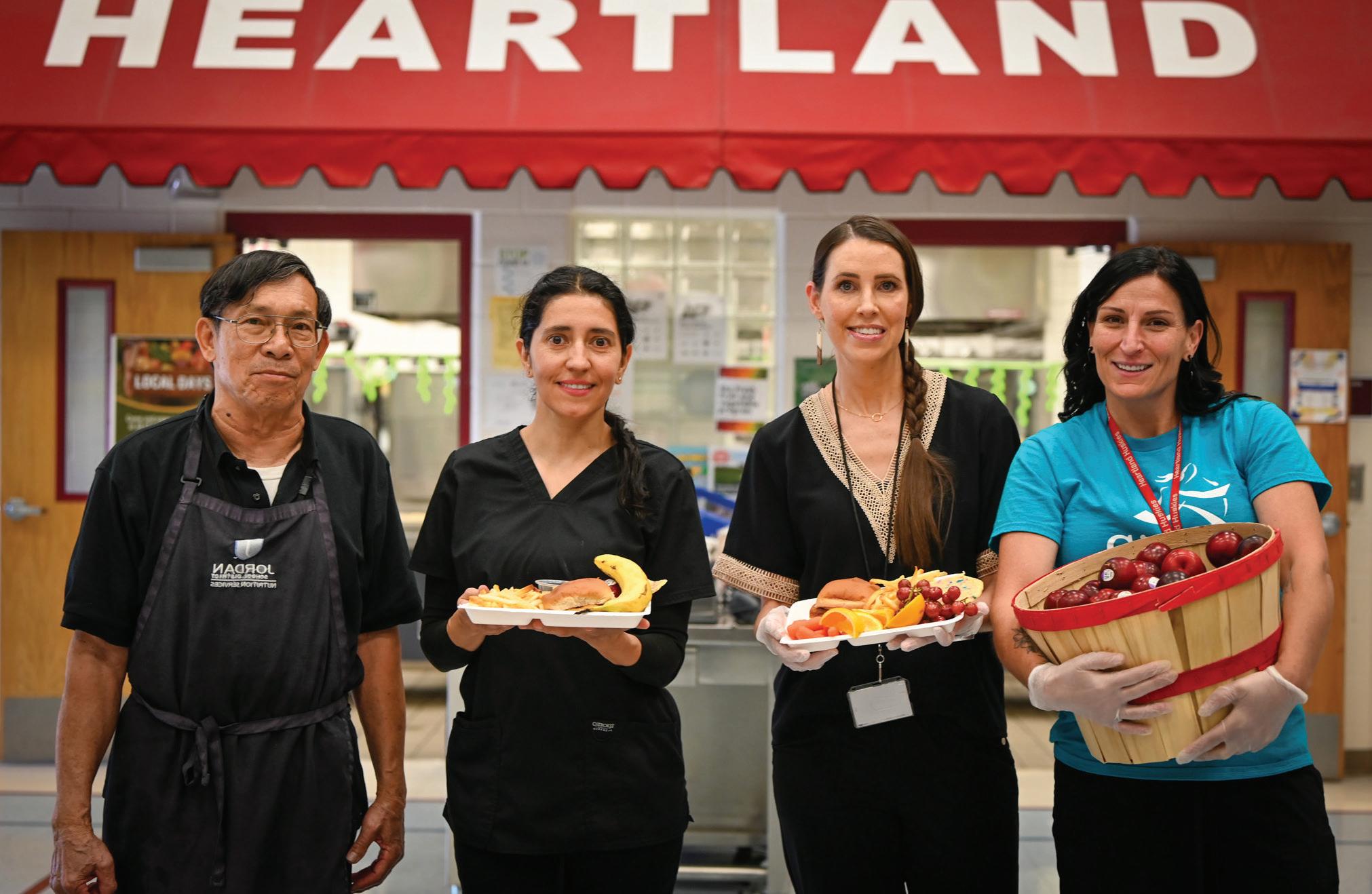
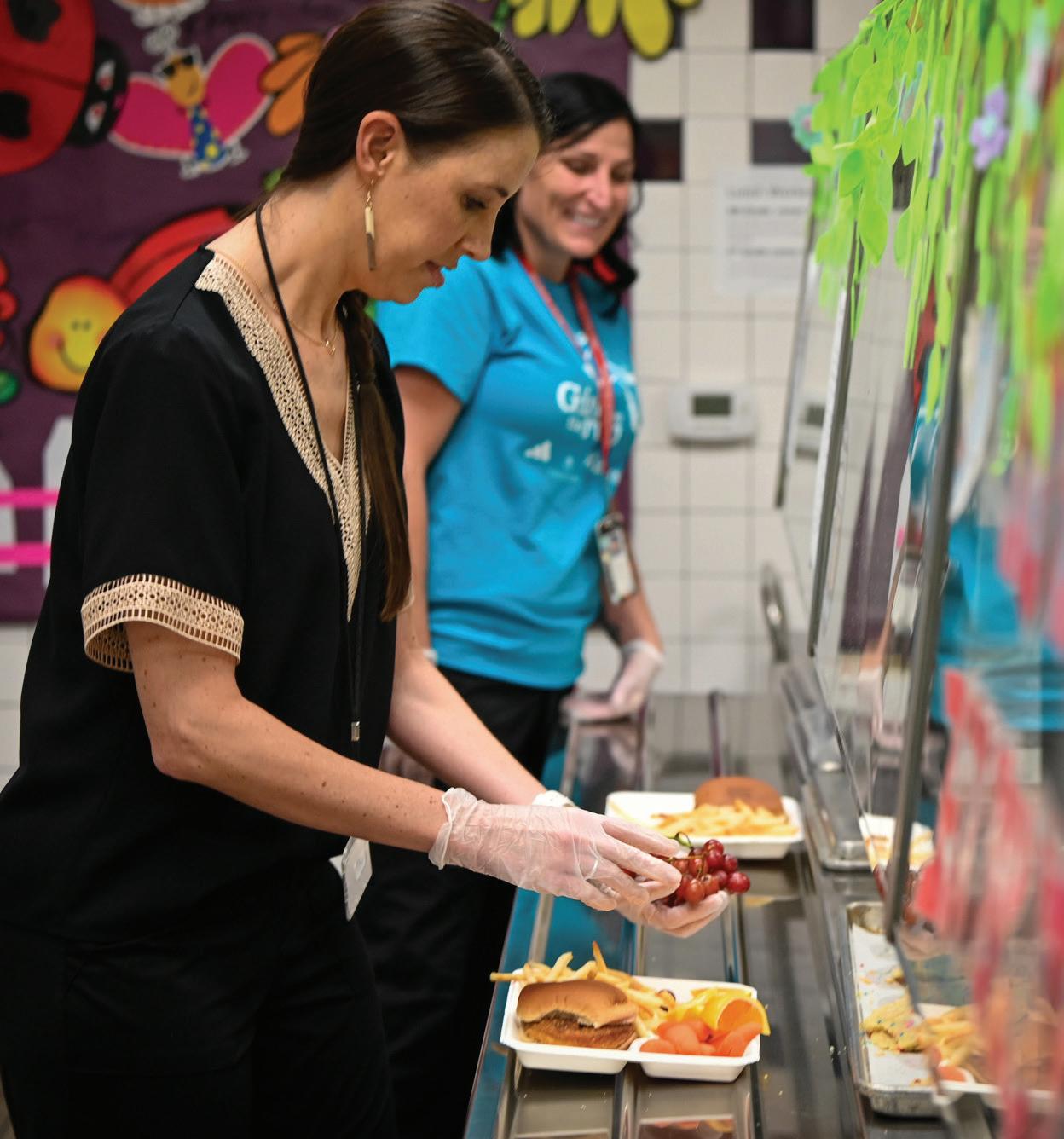
Getting help from Heartland Elementary’s nutrition services staff, Jordan School District Director of Nutrition Services Katie Bastian ensures students have healthy food options, meeting federal guidelines. (Photo courtesy Doug Flagler/Jordan School District)
Jordan School District Director of Nutrition Services Katie Bastian fills a summer meal lunch tray as Heartland Elementary’s lunch manager Kimberly Staford looks on. (Photo courtesy Doug Flagler/Jordan School District)
How the Food Truck League changed Utah’s dining culture
More than 250 trucks serve up vibrant menu items at thousands of events each year.
By Peri Kinder peri.k@thecityjournals.com
It’sbeen 10 years since the Food Truck League held its first event at Sugarmont Plaza in Salt Lake County. Organizers didn’t know what to expect but figured they’d be lucky to get 500 people to attend. When 2,000 people showed up, Food Truck League Founder Taylor Harris realized he might be on to something.
A decade later, food trucks have transformed Utah’s culinary landscape, introducing cultural fare, fusion meals and unique twists on old favorites. More than 250 food trucks are registered with the Food Truck League in Utah, each serving vibrant, bold and palate-pleasing menu items at approximately 10,000 events annually.
“As far as small companies coming up, Utah is an entrepreneur-friendly place,” said Eliot Steimle, Food Truck League general manager. “For anyone who wants to get into a restaurant, a food truck is a nice half-step in that direction, where they can get experience, find something they can experiment with and build a following.”
Food trucks like Cupbop, Waffle Love and Salt Lake Barbecue have taken their
menus into brick-and-mortar locations or food halls where they can expand their customer base. Other chefs like the ability to travel across the county, sharing their food with new communities.
Successful members of the Food Truck League utilize savvy marketing strategies and leverage social media platforms to cultivate loyal fans. Whether it’s behind-thescenes content, interactive videos, daily location updates, tailored hashtags, curated photos or exclusive items sold only at specific events, creative brand-building is an important part of a food truck’s story.
“It’s fun to watch them come into their own,” Steimle said. “Most of the time, it’s a chef who starts their food truck, but that marketing element of trying to figure out what their brand is and their identity, that part is really fun.”
As the state’s food truck industry evolved, catering everything from office lunches and corporate events to weddings and concerts, chefs have learned that flexibility and collaboration are some of their best tools. Being able to adapt to weather conditions, listening to customer feedback and pivoting when needed can help a food truck owner stand the test of time.
Legislation and permitting for food trucks have also improved over the last few years. When food trucks first appeared on

Since its first event in May 2015, the Food Truck League has grown to include more than 250 food trucks, serving thousands of people across Utah each year. (Courtesy of the Food Truck League)
the scene, every city had different regulations and licensing requirements that owners had to deal with. Often, food trucks had to obtain health permits, fire inspections and business licenses for each city they visited.
“Two or three years ago, the state legis-
lature passed a bill that essentially got rid of all of the secondary permits and licenses,” Steimle said. “That was a huge game changer for the food trucks.”
Not only do food trucks introduce new foods to residents, but food truck events bring the community together, turning parking lots into social gatherings and encouraging inclusion through global flavors. Mexican foods, pizza and barbecue seem to be the most requested trucks, but Hawaiian fare, dessert and breakfast items are also popular.
Several cities host food truck nights and Midvale recently opened a plaza built for food trucks next to City Hall. The idea of connecting people is a prevalent theme of the Food Truck League, whether it’s foodies, neighbors or city residents. The League is also dedicated to building a community for food truck owners and offers coaching and feedback to help them improve.
“We try to host an event every year where all the food truck owners get together, network and talk, outside of having to work in the food truck,” Steimle said. “That’s a lot of fun and creates a great opportunity for them.”
To browse the selection of food trucks, book trucks for a special occasion or to search for events where food trucks will attend, visit foodtruckleague.com or follow @ foodtruckleague on Instagram. l







New Bluffdale McDonald’s is open for business
A new McDonald’s restaurant has opened in Bluffdale, the first-ever in the community.
By Tom Haraldsen t.haraldsen@mycityjournals.com
McDonald’s has opened its first restaurant in Bluffdale, and Mayor Natalie Hall said, “We’re so thrilled that McDonald’s has come to our city–it fulfills an American dream.”
During ribbon-cutting ceremonies on July 7, the mayor said everyone has a connection in some way to McDonald’s during their childhood or adulthood. “Whether it be the jingles at McDonald’s or the food, we feel that connection. We love that they’ve come here to be part of our community.”
Store owner Rob Sparrer expressed his excitement at the newest of his family’s McDonald’s restaurants, which is located at 13906 S. Redwood Road, just south of Bangerter Highway.
“It’s a great location, we’ve got a great team,” he said. “It’s always fun to see a new restaurant come to life and take on its own personality. We have a super great manager and a team working here.” He said the store will initially employ 90 people.
Hall said the new McDonald’s location is the result of hard work and patience.
“It’s been years and years, looking towards developing this area,” she said. “We had to buy surplus property from UDOT.
In order to have a prime corner, we needed to do a little juggling to see how we could make it work.
“Economically, every business supports and contributes to our economy,” she said. “But even more than the economy, it really is about services in your community so you don’t have to leave and go elsewhere. My family–they’re big fans of McDonald’s breakfast. And my husband loves the Diet Coke.”
This is the 32nd McDonald’s restaurant owned by the Sparrer family. His father Charles Sparrer opened his first franchise on 3500 South in West Valley City in 1975. The family will be holding a 50th anniversary celebration at that location in September. That store was rebuilt a few years ago and the family still has original bricks from the first restaurant “from where it all started.”
Sparrer said the corporate offices handle the real estate side of the business and became convinced that the Bluffdale location was the right place for the new restaurant.
“We always say our part of the store is from the wallpaper in,” he said. “We knew this was an area that is booming and a great place to be. So McDonald’s puts the deal together and then I get the opportunity to buy the franchise and open it and run it.”
The Sparrer family owns most of the McDonald’s on the westside of the Salt Lake Valley, as well as several locations in northern Utah County and out to Tooele. l
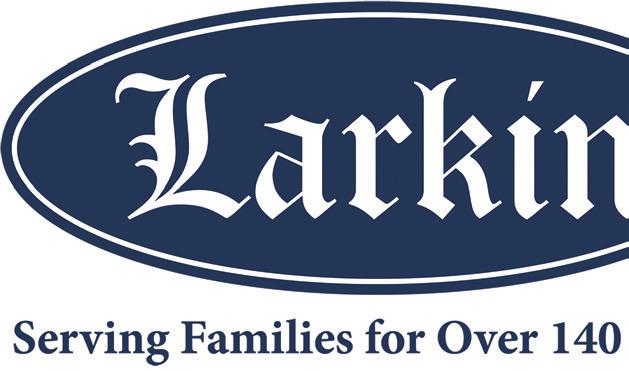
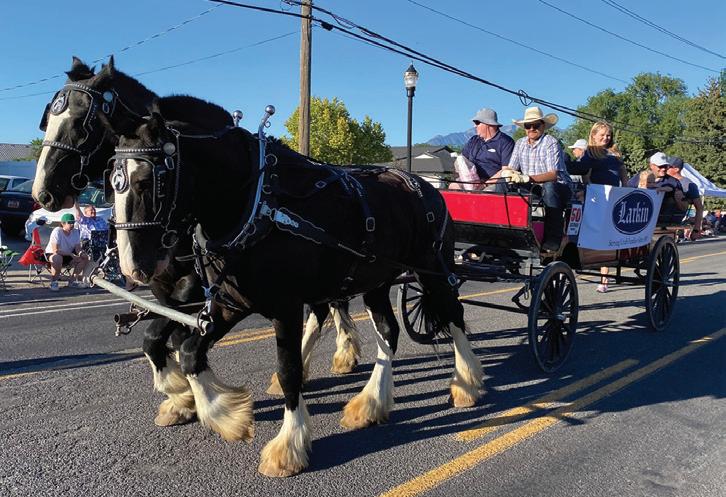


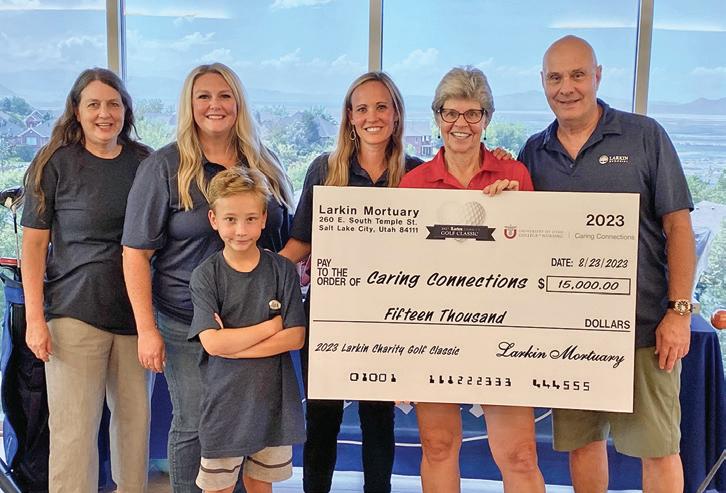

Larkin Mortuary’s dedication to the Utah community is deeply rooted in its history and family values. For over 140 years, spanning seven generations, the Larkin family has proudly served Utah families in their time of need. This commitment extends beyond providing funeral services; Larkin Mortuary actively engages with the community by hosting events and giving back through various service initiatives such as the annual Memorial Day Program, golf tournament, Trunk or Treat and Live Nativity.
Store owner Rob Sparrer joined Mayor Natalie Hall and local dignitaries to cut the ribbon at the new McDonald’s restaurant in Bluffdale. (Tom Haraldsen/City Journals)


Tips and tricks for lunch remix
Help for parents looking for healthy and fun school lunch ideas.
By Jet Burnham j.burnham@mycityjournals.com
Ultra-processed foods, sugar and synthetic food dyes are the latest antitheses of healthy childhood nutrition. The USDA has called for changes to school breakfast and lunch menus that limit sugars and utilize locally sourced products. And the Utah Legislature just passed a bill to ban synthetic dyes and certain additives in foods served in Utah schools.
“There's definitely a big trend moving towards the more natural side of things, or trying to move away from that processed food and the artificial dyes,” Sharon Turner, a certified nutritionist, said.
Healthy food not only fuels kids’ physical development but it also boosts their ability to learn, said Turner, who works at the Utah State Board of Education.
“Students need to show up nourished and healthy to learn and perform their best, so it's important that they're getting a good breakfast and a good lunch, and they're able to pay attention in class and socialize and get the full benefit of their educational experience,” she said.
Keeping track of what kids should and shouldn’t be eating can leave parents feeling overwhelmed and unsure about what to pack in school lunches. Turner suggests three tips
to ensure kids have healthy, appealing and safe food to fuel their learning as they head back to school.
1. Pack a variety. Kids should eat an assortment of foods from wholesome food groups—fruits for fiber, carbs and natural sugars, and vegetables for nutrients such as iron, beta carotene and antioxidants. Whole grains and proteins complete the meal.
Try this: Charcuterie boards are a healthier reinterpretation of the Kraft Heinz Lunchables, which have always been popular with kids. Create your own by mixing and matching different ingredients from a variety of food groups and arranging them in a compartment-style container. Punch up the appeal with whimsical shapes created by cookie cutters or food molds.
2. Pack protein. “The best thing to do would be to pack something protein rich to keep the student satiated throughout the day,” Turner said. Options include hard boiled eggs, nuts, seeds, jerky, cheese, chicken salad, hummus, beans, peanut butter or protein pancakes, quinoa granola bars, edamame and overnight oats.
Try this: A protein-packed, crunchy alternative to potato chips is easy-to-make roasted chickpeas. Rinse and drain a 15.5 oz can of chickpeas/garbanzo beans. Let dry on a paper towel for 15 minutes. Toss with 1 tablespoon of olive oil, 1 teaspoon garlic salt and ½ cup finely grated parmesan cheese. Spread seasoned chickpeas on a baking sheet and bake for 25-30
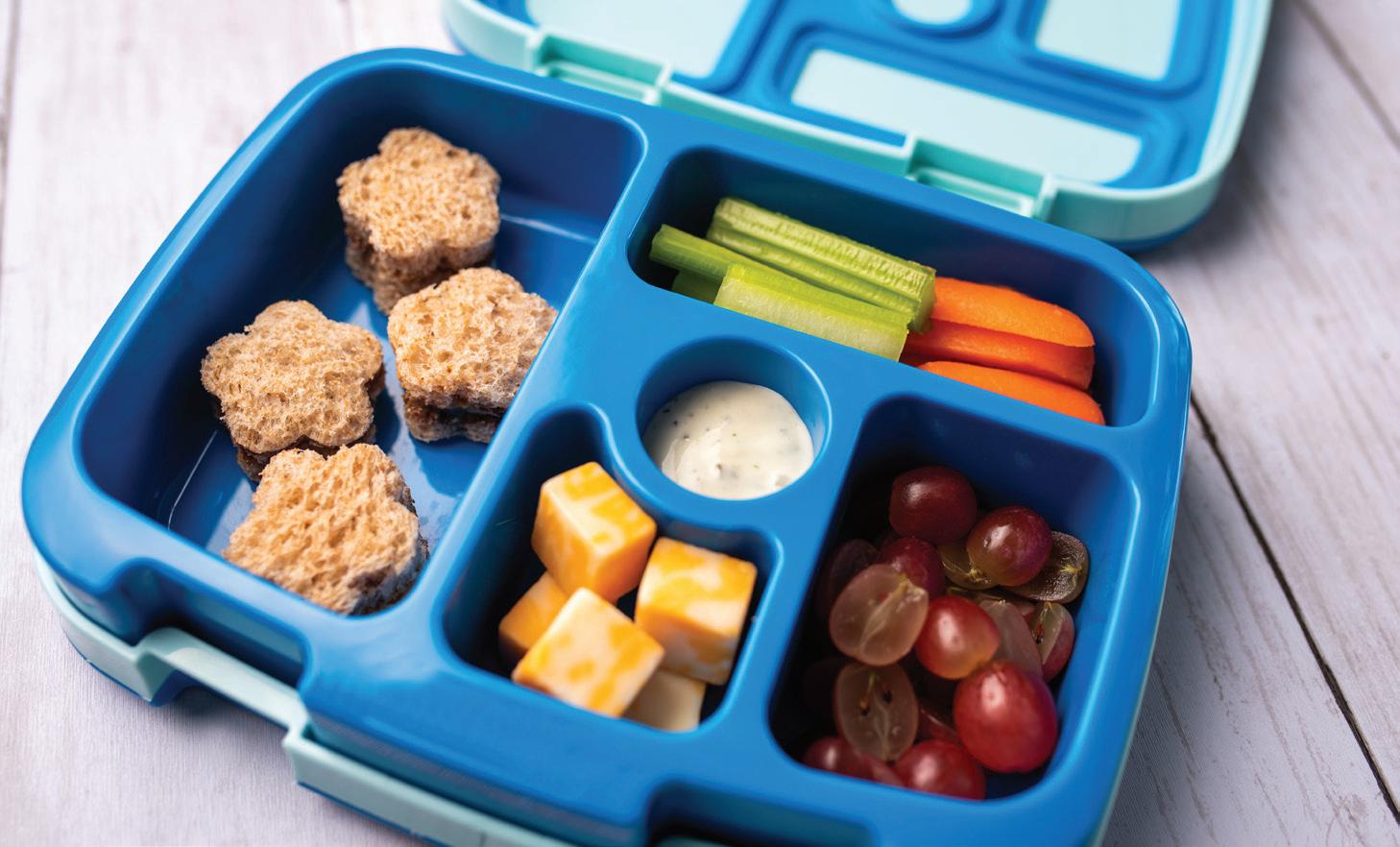
minutes at 400 degrees or until crunchy. Recipe by Pretty Providence.
3. Pack ice. Send foods containing mayo, meat, dairy or eggs in insulated bags with an ice pack. “Not only are you making good choices, but the food is stored properly and safely as well, and it's not going to heat up and make the child sick,” Turner said. If that’s not an option, stick to foods that are shelf stable and appealing at room temperature such as crackers, muffins, freeze dried fruits and vegetables, trail mix or unpeeled whole apples or bananas.
Try this: Laura Fuentes of the website
MOMables suggests ice packs should be placed directly by the foods that need to remain cold. However, ice packs can add to the weight of an already heavy backpack and can also sometimes go missing. Her solution is to substitute ice packs with frozen food items that will keep foods cold but eventually thaw to become part of the menu. Foods you can freeze as an alternative for an ice pack include a juice box, bottled water, yogurt tube, applesauce pouch, banana (peeled), berries, grapes, pineapple or mango chunks, mini muffins and cheese sticks. l

Containers with compartments creates a colorful charcuterie-style lunch. (Adobe stock photo)
By Julie Slama j.slama@mycityjournals.com
Whether aspiring of becoming a sous chef, planning to serve street tacos from a food truck or seeking a parttime restaurant job — one thing is almost always required first: a food handlers permit.
Many states, including Utah, require food service workers to complete food safety training before receiving their permit. This applies to those who prepare, serve or handle food for public consumption from restaurant staff and caterers to food truck operators and others whose roles involve direct contact with food.
In Utah, earning a food handlers permit means completing a 75-minute training course focused on food safety. The course teaches how to prevent food and surface contamination, use proper time and temperature controls to avoid foodborne illnesses, and maintain a clean and sanitary environment for food preparation and service, explained Cassandra Fairclough, program specialist at the Utah De -
Before handling food, handle this

Obtaining a food handlers permit may be a good idea to work in the food industry profession in Utah. (Photo courtesy of Salt Lake County Health Department)
partment of Health and Human Services.
“It shows you understand the basics of food safety,” she said. “There are five or six things that are very concerning for food protection that can cause illness so those are some of the things taught in the training classes, like handwashing hygiene, cross contamination in food, temperature control — holding at the right temperature for the correct amount of time and those factors.”
Another significant focus is proper chemical usage, said Jeff Oaks, food protection bureau manager for Salt Lake County’s health department.

“There's a component of dishwashing that has to be done,” he said. “You have to learn how you wash dishes in a restaurant because that's different than in your house with a triple sink and not a double sink.”
After the training, participants take a 40-question exam and must score at least 75% to pass. In Salt Lake County, those who pass will receive a temporary permit; the official Utah Food Handlers Permit will be mailed within 30 days. The permit is valid for three years. The course must be retaken for renewal.
Since 2013 the Utah Department of Health has approved third-party agencies to conduct the training, although local health departments can provide training as well and they are responsible for issuing the permits. From July 1, 2023 to June 30, 2024, Salt Lake County Health Department issued 41,240 of the state’s 109,865 food handlers permits.
To find a certified provider, visit the state’s approved training list: www.epi. utah.gov/wp-content/uploads/foodHandler_list.pdf. Providers may offer in-person or online options, sometimes in multiple languages. Check to ensure the online courses are compatible with all devices and operating systems.
The base cost of the training is $15, though agencies may include additional processing or administrative fees. In some cases, employers may cover the cost or offer group discounts.
Additional licenses, permits or certifications may be required for specific roles — such as serving alcohol, being a food manager, running a food truck or operating a booth at a farmers market.
“Different agencies will have requirements,” Oaks said. “In Salt Lake County, all restaurant workers have a food handlers permit, but for example, there are companies that package produce locally, like a bag of carrots or lettuce, and they are regulated by the state’s agriculture and food department.

But within their facilities, they require food handlers permits or some other certification. Some companies may say, we still want you to get a food handlers permit. We have almost 5,500 restaurants (and others that serve food) so all their employees either have managers’ certificates or food handlers permits. Usually, the grocery store employees have food handlers permits if they're working in the deli or the butcher shop or the produce, where they're cutting and doing food preparation and established concessioners such as the (University of Utah) Utes or Utah Jazz have food handlers permits.”
“It’s best to check with your local health department to get specific conditions and information on the type of food service that is being provided so they can help people learn what is required,” Fairclough said.
She said the food handlers training and certification program is regularly reviewed by state officials, local health departments and industry professionals to ensure it aligns with the latest (2022) version of the FDA Food Code, along with Utah-specific amendments. The Food Code is designed to protect public health and provide a standardized approach to food safety across various service environments.
Oaks, who has taught food handlers permit classes, said he had parents who would bring their kids to get a food handlers permit.
“It’s good knowledge and they wanted their kids to know; it had nothing to do with employment,” he said. “If you want to up your game for food safety, food preparation or food serving at home or wherever you might be, it's not a bad idea to get it. Not all states require a food handlers permit, but I’m glad Utah does. I'm glad our legislature and our state health department see the value in it, so there's at least a minimum standard for food workers.” l








Community Hero: Max Elliott Celebrates 65 years of dedicated service to Davis County
By Becky Ginos becky.g@thecityjournals.com
It’s been 65 years since Max Elliott started his career in the Davis County Surveyor’s Office and he’s still going strong. Elliott was just reelected as Davis County Surveyor for another three years – so retirement is in the distance.
“Surveying is kind of a unique line of work,” said Elliott. “You’re more outside than inside.”
It was more or less luck that brought him into the field, he said. “I worked under Don Davis then worked under Glenn Austin. When he retired I served the remainder of his term.”
Elliott served as the elected surveyor for eight terms and in 2021 started his ninth term. During that time he had only one challenger for his position.
“If there was an election and they found out he was running nobody was willing to run against him,” said Administrative Secretary Louise Miller. “Everybody respects him. He knows everything about Davis County. If you ask a question he’ll know where to find the material.”
Max is wonderful to work for, she said. “He lets us do our job but he’s there if needed. I’ll be working on something and he'll ask if I need to sit down or suggest I need time off. He cares about us.”
He treats everyone with respect and kind-
ness, Miller said. “If the public comes in and needs something he’ll give the answer but if he doesn’t know the answer he’ll search until he finds it.”
“I have known and worked with Max for many years,” said Chief Deputy Surveyor, Kyle M. Corbridge. “One day we were surveying in an open field and we were using a 300 foot metal chain to measure distances with. Max took the front end of this metal tape and I held onto the rear end of the chain.”
Corbridge said Max went out about 295 feet from him to set a point in the ground. “I was standing next to an electrical fence the farmer had to keep his livestock in. I was holding onto the reel of this tape secured onto a wooden handle. I somehow ‘accidentally’ made contact with this fence and about 300 feet away I heard a commotion. It took some time before he was able to laugh about that.”
“I’ve seen a lot of changes in 65 years,” said Elliott. “I used to work with steel tapes that were 300 feet long. Now we’ve got global system positioning. It can tell within a dime in an area if it’s done right.”
There’s satisfaction in keeping the real map (which is the earth itself) in place, said Elliott. “It’s quite a job keeping those points in place with all of the growth.”
Elliott said surveyors are concerned that in a few years there won’t be enough people interested in the field to follow in their footsteps.



“Most surveyors are in their 50s, 60s or 70s. I know if they got involved in doing it they’d be excited to come into the profession. I don’t think you can meet anyone who would say they don’t enjoy it.”
“I know him as a man of integrity,” said Corbridge. “As a surveyor he is thorough, en-

suring the work is being done in an accurate and precise manner. He has been a great leader, teacher and mentor through his examples and patience.”
“I thoroughly enjoy this profession,” said Elliott. “I got into it and stayed.” l

Funeral arrangements are a deeply personal choice. Preplanning provides you with the time needed to make practical, detailed decisions that reflect your standards, lifestyle, taste and budget. And we assure you and your family that the choices you make will be carried out as planned.
Max Elliott stands on Frary Peak. Elliott has three more years in his term as Davis County Surveyor (Courtesy photo)
When the cafeteria closes: The harsh reality of summer hunger for kids
Summer is the most difficult time of year for students who rely on school lunches and breakfasts.
By Lizzie Walje l.walje@mycityjournals.com
The Utah Food Bank has historically dubbed summer as the official season of hunger. To some, this might come as a surprise. However, when schools shut down for the summer, so do breakfast and lunch programs, which students often rely on to ensure they’re receiving meals throughout the day.
According to Feeding America, the country’s largest nonprofit organization dedicated to combatting hunger, one in five children in the United States are currently facing food insecurity. In Utah specifically, the ratio is one out of eight people for adults, and one out of six for children. In Utah alone, roughly 220,000 kids rely on school lunch and breakfast programs for their daily nutrition.
The effects of hunger have long been studied and documented, showcasing that regardless of age, missing even one meal can result in a slew of negative consequences, both chronic and acute. Feeding America explains why food in-
GRIEF HAS NO TIMELINE
Grief is an individual journey with a path as unique as each one of us. To o er support and hope, we provide various Grief Support Services for those who are mourning a recent or past loss.
security is particularly dangerous for our youngest residents:
“For children, food insecurity is particularly devastating. Not having enough healthy food can have serious implications for a child’s physical and mental health, academic achievement and future economic prosperity. Research shows an association between food insecurity and delayed development in young children; risk of chronic illnesses like asthma and anemia; and behavioral problems like eating disorders, hyperactivity, anxiety and aggression in school-age children.”
Who you are can also have bearing on your potential to face food insecurity. While food insecurity is an issue that effects people of all backgrounds and circumstances, Black and Latino children are twice as likely to face hunger compared to their white counterparts. Another common risk factor for childhood food insecurity is growing up in a single parent household. In 2022, children who lived in a single income household, typically led by single mothers, were 33% more likely to experience hunger.
Historically speaking, summer is always a difficult season for reconciling hunger. However, 2025 has presented new challenges, especially following budget








cuts implemented by the U.S. Department of Agriculture. Back in March of this year, two federal programs were cut, resulting in a combined loss of nearly $1 billion in funding for schools and food banks to buy directly from local farms, ranchers and producers. At the time, the agency claimed it was a decision that would help “return [the agency] to long-term, fiscally responsible initiatives.”
The decision was made by the Trump Administration and Elon Musk’s Department of Government Efficiency or DOGE. At the time, they claimed the decision to cut funding was a means to slash federal spending, and therefore, reduce government waste. Previously, the USDA programs in question were funded through the agency's Commodity Credit Corporation, a Depression-era fund created to buy products directly from farmers. The cuts resulted in a loss of about $660 million in funding this year for the Local Food for Schools program, which is active in 40 U.S. states, including Utah.
Despite the jarring budget cuts, the Utah Food Bank sprang into action, as they are accustomed to doing ahead of the summer months. Back in March, they held an event called Feed Utah which was lauded for its convenience. Ahead of the event, pamphlets were left on residents’ front doors which explained how they could participate by either gifting a financial donation or leaving a bag of nonperishable food on their doorstep, which would then be picked up by Food Bank volunteers and employees.
“So it’s really hard for families who have a fixed budget to have money left for food. Do they choose to pay the rent? Do they choose to pay the power bill so they have heat?” said Utah Food Bank CEO and President Ginette Bott. “We recognize that not everyone can [donate] at this time. But at some point, in the future, please help us, or your neighbors.”
After the success of the Feed Utah event, it was time again for the food bank to
start tackling its most critical season: summer. Preparations for summer often begin as early as Thanksgiving and Christmas of the prior year, and with the added stress of federal budget cuts looming, it was imperative to get a handful of programs and events on the docket.
Incidentally, the USDA will still be providing funds for the Utah Food Bank’s Summer Food Service Program (SFSP). This program expands upon the food bank’s Kid’s Café program, which focuses on bringing meals to children 18 and under during the summer months. The program runs through Aug. 8 and includes two means of operation. Children can either go to an open site, where anyone under 18 will receive a meal, or they can access a closed enrolled site if they’re participating in specific activities.
Each site will offer either individual daily meals or a weekly box containing seven breakfasts and seven lunches. Meal types and schedules vary by location, but all sites will be closed June 16, July 4 and July 24 in observation of state and federal holidays.
To find a meal site near you, visit www.UtahFoodBank.org/SummerMeals, text “SUMMER” to 914-342-7744, or call the USDA National Hunger Hotline at 1-866-3-HUNGRY. More than 300 sites are available statewide, with Utah Food Bank operating 60 of them. Children must be present to receive a meal.
Another helpful program children can utilize this summer is SUN bucks or summer EBT. Eligible families will receive a $120 credit for each school-aged child in the household. To learn all about the SUN bucks program, who qualifies, how to apply, and more, visit www.jobs.utah.gov/ customereducation/services/sebt/index.
For adults in need of food assistance, the Utah Food Bank is a great place to start locating resources. Visit www.utahfoodbank.org/get-help/. This link can also be used by adults who are wishing to donate or volunteer at the food bank. l
This summer the Utah Food Bank will be bringing back its popular kids cafe program, which helps bridge the nutrition gap during the months when school is not in session. (Utah Food Bank)
Survey seeks questions readers have for their local government candidates
Fill out our survey so your candidates know what questions to answer for our Voter Guide.
Welcome to the City Journals survey! We're happy to have you here and for the opportunity to learn about how our newspapers are being utilized in our communities.
In the October issues of our newspapers, we will publish a Voters' Guide to provide readers with information about the candidates listed on each municipal ballot.
We understand how voters can visit many different resources and websites and end up looking at the same information—if not the exact same wording or candidate platforms. We hope to provide readers with the information they want to know about each
candidate. Take a moment to consider what information ultimately makes or breaks your decision to vote for a specific individual in our local elections.
“It’s important to have candidates answer the actual questions their constituents would ask them,” said City Journals Creative Director Bryan Scott.

“This is your chance to do that.”
Please respond to the survey found through the QR code, which will take less than three minutes to complete. Your response will help guide the design of our Voters’ Guide.
The “submit” button must be clicked before Monday, Aug. 18 (at 11:59 p.m.).
Thank you for your continued readership and support of your local staff here at the City Journals.
August is National Self Awareness Month





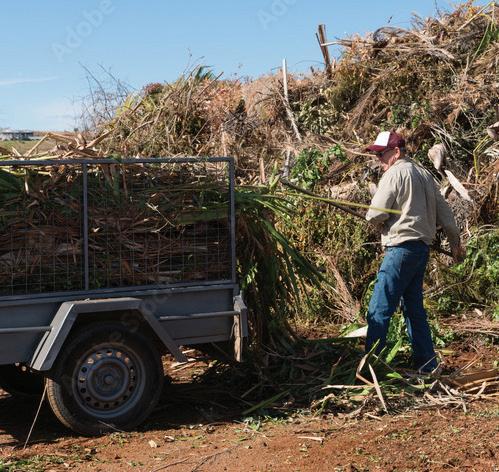











































Scan this QR code to fill out the short survey.





















Alex Elggren Band plays on July 3 at Riverton City Park. (Travis Barton/City Journals)
The carnival rides are a regular every year at Riverton Town Days. (Travis Barton/City Journals)
Riverton Town Days ran from June 23 to July 5. (Travis Barton/City Journals)
Lots and lots of chicken was on hand among the food trucks at Riverton City Park. (Travis Barton/City Journals)
Welcomes First McDonald’s with Ribbon Cutting & Community Celebration

lu
app. Residents enjoyed giveaways like free McNuggets and McCrispy Strips meals with qualifying purchases. The event marked a major milestone for the growing community, bringing new jobs and family-friendly fun to Blu dale.
13883 S. Redwood Rd. Blu dale, UT 84065


We are the bridge between businesses and the community in Bluffdale, Herriman, and Riverton.
WWW.MOUNTAINWESTCHAMBER.ORG
The Mountain West Chamber of Commerce celebrated the grand opening of three new businesses with ribbon cuttings this month. We are so pleased to welcome these entrepreneurs, they will enrich our local economy and bring an array of great new products and services to our area.
BEEJERS VINYL & COLLECTABLES
If you love vinyl records and other fun nostalgia there’s a great new shop to check out in Herriman. Beejers Vinyl & Collectables is now open with a great niche store inside Peace on Earth Coffee in MVV. Stop in to meet the owner Brian Johnson and pick up some great finds!
ZIONS BANK
A new Zions Bank branch has opened its doors in Herriman!
Located at 5048 W Herriman Blvd this new full-service branch offers a full range of personal and business banking services. Stop in to meet their friendly staff and learn about their current promotions.
GAVANE SPA
Looking for ways to pamper yourself? Gavane Spa is now open with an array of amazing services to help you or your loved ones rejuvenate! Book a refreshing spa experience with them at their new location at the Soleil Loft in Herriman.

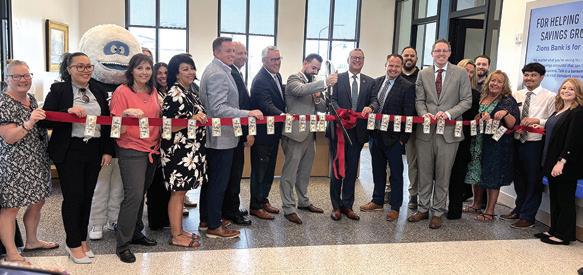
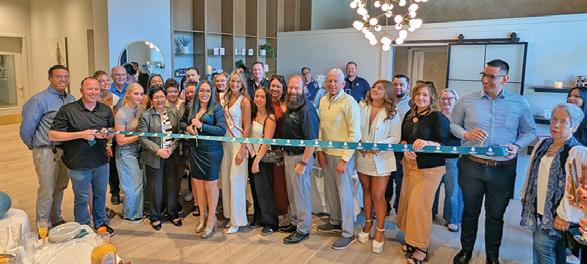









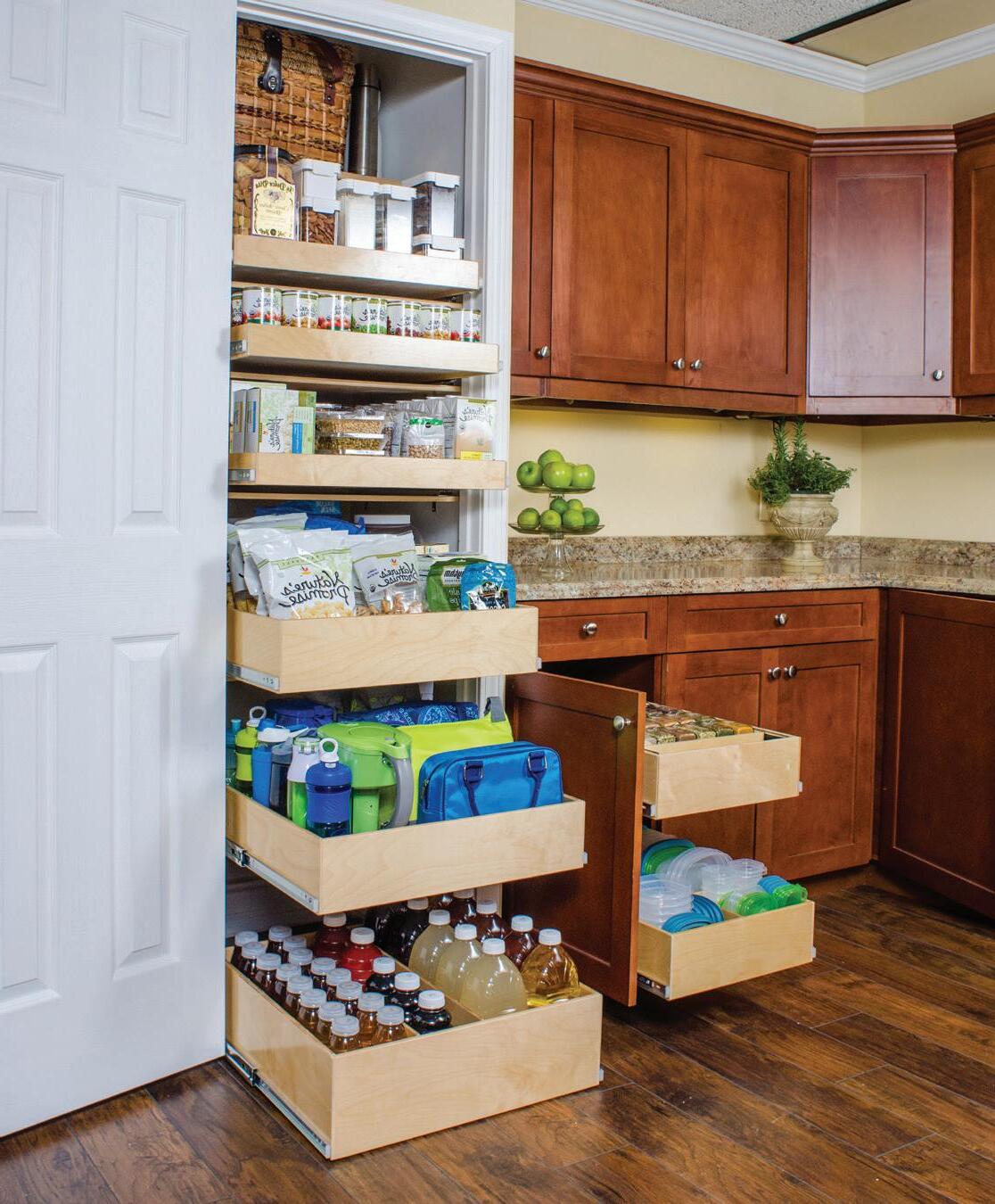

















Lita’s Child Development Center
After working in public and tribal schools in Arizona, Ariadna Crockett followed her dream and opened a childcare and early childhood education center to support families in the community. Crockett owns and directs Lita’s Child Development Center in Riverton. She has more than 18 years of education experience, working with children from preschool to high school, and more than six years as a full-time kindergarten teacher. Ariadna holds teaching credentials in general and special education and speaks English and Spanish. She earned her teaching degree in Mexico City and completed an Elementary and Special Education degree at Northern Arizona University in 2017.
What services do you provide at your center?
We offer high-quality childcare and preschool education for children from infancy to age 5. Our services include: Spanish and English language development, early sign language, social-emotional learning, structured games, group activities, creative play and daily routines that build healthy habits.
Why did you start this business?
I opened this center after working with families and realizing the need for a safe and nurturing educational environment that supports child development in a holistic and loving way. Although I officially launched my daycare recently, the foundation of this business was built on my lifetime of experience as a mother of eight children and an educator since the 1980s.
What sets your company apart from your competitors?
We’re more than just a daycare center, we’re an extension of your home. We blend love, structure and learning in a warm, family-like
environment. Children in our care feel safe, valued and happy, as if they were with family.
Our daily routines are designed so children learn naturally through songs, games and guided play. We focus on academic preparation and building character, independence, social skills and emotional confidence.
Parents trust us because we see each child as unique and important, and we partner with families to support their child’s growth. Our bilingual program and introduction to sign language help children develop strong communication skills from an early age.
How do you help the families you serve?
We solve a very real problem for working families who need trustworthy care and want their children to thrive emotionally, socially and academically. We focus on values like kindness, respect and independence, preparing children for kindergarten and for life.
Who is your ideal client?
Our ideal clients are parents who value education, emotional care and structured learning in a warm, family-oriented environment. Many of our families are looking for more than just babysitting, they want a place where their children are seen, supported and inspired to learn.

How do potential clients choose between you or a competitor?
Parents choose between centers based on trust, safety and educational philosophy. What sets us apart is our personal and professional experience, our bilingual curriculum and our passion for helping children feel important and capable. Families who visit us can feel the difference. Our environment is designed for growth, love and learning. We treat every child like family.
Facebook: Lita’s Child Development Center
4367 W. Salish Circle litachildcare@gmail.com

What should potential clients consider before working with you?
Come visit us! Seeing our center in person is the best way to understand how committed we are to your child’s development. I always recommend meeting face-to-face, asking questions and sharing your child’s needs and interests with us so we can partner with you from day one.
What is your favorite service?
My favorite part is our bilingual language program. Teaching children Spanish and English opens doors for them and boosts brain development. It helps families feel connected to their roots while preparing children for a global world. I love introducing kids to basic sign language, which helps them communicate before they have all the words.
What else do you want readers to know?
This is a place where children are seen, loved and respected. I bring my heart, training and years of experience as a teacher and mother into everything we do. My mission is to support each child’s full development and give families peace of mind knowing their child is in excellent hands.



Are you a business leader?
At no cost, the ElevateHERTM Challenge is easy to accept and will benefit your company.
Join businesses across Utah in our mission to elevate the stature of women’s leadership. Take the ElevateHERTM Challenge and stand with other businesses as we pledge to elevate women in senior leadership positions, in boardrooms, on management teams and on politcal ballots.

Bridging the gap: Making farm-to-fork products affordable
Misconceptions about the cost of locally-produced food keep some families from enjoying the benefits.
By Peri Kinder peri.k@thecityjournals.com
Local farmers markets are welcome events, recognized for delivering fresh, seasonal produce and food items. But for some families, the price of farm-fresh products seems to be too high, creating a nutritional divide for lower-income households.
Natalie Loots wants to change that narrative. She is the Community Food Security Program manager with the Utah Department of Health and Human Services and said there are several programs available to make farmers markets accessible and affordable.
“Our main goal is to make local foods, like fruits and vegetables and other high-nutrition foods more affordable for low-income folks,” Loots said. “Our main program that we operate is called the Double Up Food Bucks program, which has been around since 2015.”
With Double Up Food Bucks, people enrolled in the SNAP program can get up to $20 of free Utah-grown produce with every visit to a participating market. The program offers a dollar-for-dollar match, up to $20, matching SNAP benefits.
“If folks go to the information booth at the farmers market, they swipe their SNAP card and they’ll get tokens for SNAP and then tokens for Double Up to use at the different vendors at the market. There’s no paperwork they need to fill out. All they have to do is have a valid SNAP card that is currently active.”
Loots said the CFSP works to eliminate barriers that limit access to nutritionally-dense foods. Initiatives like the Senior Farmers Market Nutrition Program offers low-income seniors a $50 farmers market voucher to use throughout the season. Utah Produce Rx partners with local healthcare clinics to create a $300 fruit and vegetable prescription patients can use at participating farmers markets.
Caroline Hargraves serves as the marketing director for the Utah Department of Agriculture and Food’s economic development division. She said while prices might be higher on some items at farmers markets, the food quality and nutritional value is much better than what can be found in many grocery stores.
“I think a lot of people don’t understand that it takes time, energy and labor to produce food. We have such a culture in America of expecting food to be cheap but people who produce it deserve a living wage,” Hargraves said. “Farmers get such a small portion of the dollar that the average consumer pays at the grocery store and
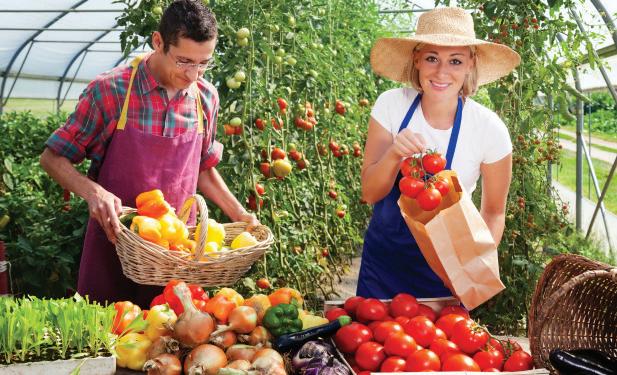
I think people don’t understand that. But when you buy directly from farmers at a farmers market, that money is going directly to them.”
Utah’s DHHS operates a local food purchasing assistance program to help socially disadvantaged farm owners. Since the spring of 2022, the program has purchased food from local farmers to distribute to families experiencing food insecurity.
More than 60,000 individuals have re-
ceived farm fresh food at nearly 600 distribution events across the state. This will be the last summer the program will be utilized, as federal funding has been cut, but organizers are looking for additional funding sources.
A 2025 Utah State University study, Cultivating Community and Commerce: A Summary of the Statewide Social and Economic Impacts of Utah Farmers Markets, found that farmers markets offer more than
just fresh produce. Communities hosting farmers markets fostered community connection, empowered small businesses and contributed to the state’s economy.
The study also found food deserts are prevalent in the state. These areas have limited access to nutritious food, affecting more than 800,000 Utah residents. Farmers markets address this dire need, so affordability is key.
“We have several initiatives at the Department of Agriculture and Food to encourage people to support local farmers and ranchers,” Hargraves said. “It does make a difference, both for that individual, like a farmer or business owner, and for the community. The more dollars we can keep circulating in our local economy, the better. But also it tastes better. With local foods, you can taste the difference.”
For more information about farmers markets affordability programs, or to find participating markets, visit uah.org/gethelp.
“Our work is aiming to make food security accessible in a way that it functions as a social determinant of health,” Loots said. “Farmers markets are for everybody, and we try to make eating local produce accessible to everybody…Access to healthy foods affects chronic disease outcomes or health outcomes, longevity and quality of life. Those are so deeply connected.” l

Locally produced food has better health benefits and can be more affordable than people realize. (Canva stock)





























County? City? What’s the difference?
Have you ever wondered what Salt Lake County actually does? If you live in one of the 23 cities in our area—like Murray, West Valley, South Jordan or Millcreek—you might think the county doesn’t affect your daily life. But the truth is, Salt Lake County helps all of us in big and important ways. Everyone who lives in the Salt Lake Valley is part of Salt Lake County.
Salt Lake County is like the glue that holds many parts of our community together. While cities take care of things like neighborhood parks and snow plowing on local streets, the county provides services that work best when shared by everyone. These regional services save money and help us all live better.
What Services Does Salt Lake County Provide?
Let’s break it down. Salt Lake County helps in areas like:
- Public Safety and Criminal Justice: The county runs the jail, provides prosecutors and public defenders, and helps with emergency response. In fact, public safety is the county’s biggest responsibility—it makes up over 74% of the county’s general fund.
- Elections: The county clerk makes


Aimee Winder Newton
Salt Lake County Councilmember|
District 3

sure elections are fair and secure. Cities contract with the county clerk for their municipal elections.
- Health Department: The county helps keep our community healthy by inspecting restaurants, giving vaccines, and cleaning up unsafe places like abandoned camps.
- Senior Services: Through programs like Meals on Wheels and senior centers, the county helps older adults stay active and connected.
- Mental Health and Addiction: The county leads programs for people who need support with mental illness or substance abuse, partnering with other groups to reach more people.
- Libraries: The Salt Lake County Library system serves most of the area (Mur-




ray and Salt Lake City have their own), giving people access to books, computers and classes.
- Parks and Recreation: From big parks and trails to swimming pools and rec centers, the county helps families stay active both indoors and outdoors.
- Arts and Tourism: The county owns facilities like Abravanel Hall and the Capitol Theatre, and brings in out-of-state visitors through conventions and tourism, which boosts our economy. The county owns the Salt Palace and Mountain America Expo Center.
- Property Tax and Land Records: The county collects property taxes (even for cities and schools) and keeps track of land ownership and real estate records.
A Government That’s Smart With Your Money
Salt Lake County has a budget of about $2 billion. While that sounds like a lot, only part of it is under the County Council’s full control. About $500 million of the total budget is what we call “passthrough” taxes—meaning the county collects it and passes it to others, like UTA or cities.
To stay financially strong, the Salt Lake County Council keeps a close eye on






spending. They’ve helped the county keep a AAA bond rating—the highest possible score, showing the county is careful with its money. The council also does stress tests and checks each department regularly to look for savings and to improve services.
Utah law doesn’t let counties collect more money just because home values rise. Instead, counties can only collect more if there’s new growth, like a new building. That keeps taxes fair, but it also means the council has to plan ahead and budget wisely.
One County. Many Communities. One Mission.
Salt Lake County doesn’t replace cities—it supports them. Whether your city needs help with road signs, snow removal or mapping, the county can step in with expertise and resources. It’s about teamwork.
The county’s job is to serve, support and strengthen every community in the region. By managing big services, using your tax dollars wisely, and working across city borders, Salt Lake County makes life better for all of us.
So next time you vote, enjoy a park, visit the library, or call for help—remember, Salt Lake County is there for you. l








There was no “gentle parenting” in the ’70s, especially at the dinner table. You either ate what was prepared for you, or you were labeled a sniveling, spoiled brat who didn’t care if children in China starved because you wouldn’t eat your meatloaf.
One time, I was forced to stay at the table until I’d eaten all my potatoes. I blame my dad. He had told me that potatoes have eyes and then lost his mind when I refused to eat mashed potatoes. I was convinced the lumps were eyeballs and I was not about to eat potato eyeballs.
I wasn’t trying to be picky, I just didn’t like things that were mushy, smelly, runny, squishy, eggy or slathered in mayo.
Grandma Stewart considered me the most coddled child in history. She could not fathom how I could reject her slimy bowl of lima beans, which included (if memory serves) onions, ham, shampoo and arsenic.
“If you don’t eat your lima beans, it just means you're spoiled,” she huffed when I put my head on the table to cry. She said the same thing when I refused to eat bread crust, cottage cheese, tuna fish or canned beets.
Side note: Grandma loved Jordan almonds, the only food she refused to share. She’d hide them from the grandkids because she knew we’d eat them. We scoured the cabinets until we found them and devoured every last one. I think that’s called a self-ful-
Foods that ruined my childhood
Peri Kinder Life and Laughter
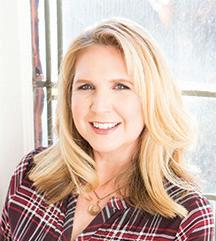
filling prophecy, Grandma.
As a kid, terrible food was everywhere. If I wasn’t being subjected to a disgusting recipe Mom found in a McCall’s magazine, I was being betrayed by school lunch ladies. They’d slide a quivering square of delicious cherry Jell-O, topped with whipped cream, onto my lunch tray. But the joke was on me when I took a big bite of the tasty dessert only to learn it was sour cream, not whipped cream. Who does that to a child? Sadists, that’s who!
While eating dinner at a friend’s house, her mom shamed me for not eating the disgusting canned peas. So, I ate it and cried. It was just another meal I was forced to eat, like a hostage.
Sometimes, I’d take a proactive approach when it came to avoiding foods I didn’t like. Mom often made chicken pockets, which were shredded chicken mixed with cream cheese, baked into crescent roll dough. I hated cream cheese (mushy,


smelly). When I saw it in the fridge, I cried. I hid the box of cream cheese behind the wilted lettuce in the vegetable bin, but Mom always found it.
Other ploys included acting sick (rarely worked), “forgetting” about dinner while playing outside (never worked), pretending to sleep on the couch (sometimes worked) and throwing a fit at the dinner table (never worked, plus I lost dessert).
I don’t know why Mom refused to accommodate my delicate palate. I was only repulsed when it came to sauces, dressings, mustard, canned foods, Vienna sausages, tuna, cottage cheese, sour cream, maple syr-
up, vegetables, macaroni salad, yogurt, the textured vegetable protein popular in the ’70s or anything slathered in mayo.
It didn’t matter. I was expected to “Learn to like it, or else!” Or else, what? A grateful digestive system? A lack of nightmares? A healthy relationship to food? With four daughters, I understand how hard it is to make meals for ungrateful children. I’ve had daughters who refused to eat pizza, spaghetti, meat, dairy products, lasagna, hamburger casserole or anything with onions. They probably have their own list of foods that ruined their childhood. That’s what therapists are for. l














Dr. Jeff Matson, DC
Dr. Matthew Smith, DC
